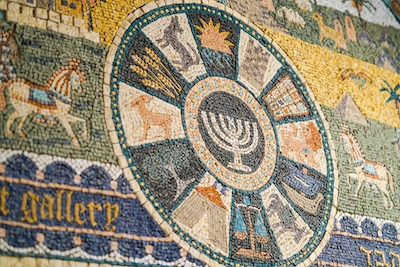On yesterday’s daf, the Talmud recounted some of the particularly abhorrent behaviors of King Herod, the Jewish king who ruled Judea from 37 BCE to 1 BCE. From that account, and from the information about Herod offered by the first century Jewish historian Josephus, it’s clear that Herod was, in many ways, the worst: an upstart, paranoid king obsessed with his second wife Mariamne, whom he ended up murdering along with many of their sons and scores of others he saw as challenging his authority.
On today’s daf, the rabbis struggle with a strange contradiction in the life of Herod: This same man who schemed and murdered and behaved so abhorrently also spearheaded, funded and completed the rebuilding and beautification of the Temple in Jerusalem. How could the same person have done such morally opposite things?
The Talmud offers us one explanation:
Herod placed a garland of porcupine on (Bava ben Buta’s head), which pricked his eyes out. One day Herod came and sat before him. Herod said: See, Master, what this evil slave (Herod) is doing. Bava ben Buta said to him: What should I do to him? He said to him: The master should curse him.

Help us keep Jewish knowledge accessible to millions of people around the world.
Your donation to My Jewish Learning fuels endless journeys of Jewish discovery. With your help, My Jewish Learning can continue to provide nonstop opportunities for learning, connection and growth.
Herod seeks to take advantage of the now-blinded Bava ben Buta to entrap him in lese majesty. But Bava Ben Buta is either onto Herod or genuinely unwilling to insult even such a wicked king.
Bava ben Buta said to him: It is written: “Do not curse the king, not even in your thoughts” (Ecclesiastes 10:20). Herod said to him: He is not a king. Bava ben Buta said to him: And even if he were merely a rich man, it is written: “And do not curse a rich person in your bedchamber” (Ecclesiastes 10:20). And were he only a leader, it is written: “And you shall not curse a leader among your people” (Exodus 22:27).
Even with some more encouragement from Herod, Bava ben Buta refuses to badmouth the king. Finally, Herod gives up his twisted game.
Herod said to him: I am he. Had I known that the sages were so cautious I would not have killed them. Now, what is that man’s remedy?
It’s worth noting that Josephus’s historical account of Herod’s reign doesn’t include any dramatic scenes of repentance. But as the rabbis of the Talmud tell the story, Herod feels regret for his murderous actions and wishes to repent. The Talmud then offers us two versions of what Bava ben Buta said to him:
He said to him: He who extinguished the light of the world, as it is written: “For the mitzvah is a lamp, and the Torah is light” (Proverbs 6:23), should go and occupy himself with the light of the world as it is written: “And all the nations shall flow unto it (the Temple).” (Isaiah 2:2)
In this version, Bava ben Buta draws a connection between the word for light in Proverbs (in Hebrew, or) and the verb to flow in Isaiah (in Hebrew, venaharu). His point is that one who extinguished the light of Torah by murdering its teachers should repent by making the Temple an even more impressive place for the entire world to visit. The second version of Bava ben Buta’s response is a bit more personal:
There are those who say this is what he said to him: He who blinded the eye of the world, as it is written: “And if it be committed through ignorance by the eyes of the congregation” (Numbers 15:24), should go and occupy himself with the eye of the world as it is written: “I will desecrate my Temple, the pride of your strength, the delight of your eyes” (Ezekiel 24:21).
Here Bava ben Buta, who has just been blinded by the king, offers a play on words about eyes — the eyes of the congregation (meaning its leader, which for Bava ben Buta meant the rabbis) and the Temple (“the delight of your eyes”). One who has blinded the rabbis (both personally, and perhaps also more metaphorically by killing so many of them) must repent by renovating and expanding the Temple.
Ultimately, the rabbis handle this strange contradiction in Herod’s behavior by dividing his life into stages: a life of sin and a later life of repentance. And for the rabbis, Herod’s abrupt recognition of his own misdeeds could only come at the hands of a rabbi — one who, despite physical torture, impresses Herod with his refusal to play into the wicked king’s hands.
The Talmud continues with an account of how Herod built the Temple and what it looked like. And as the rabbis themselves say later on in today’s daf, regardless of how exactly it came to be built, Herod’s Temple was an extraordinary thing to see:
One who has not seen Herod’s building has never seen a beautiful building in his life.
Read all of Bava Batra 4 on Sefaria.
This piece originally appeared in a My Jewish Learning Daf Yomi email newsletter sent on June 29, 2024. If you are interested in receiving the newsletter, sign up here.



